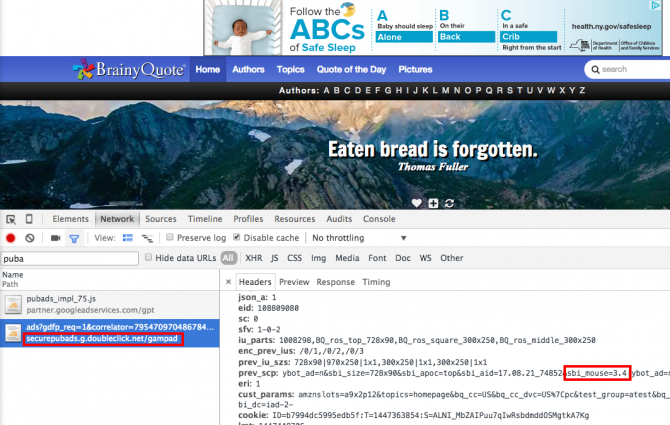Sonobi
Example Publisher: BrainyQuote.com
Domain: http://apex.go.sonobi.com/
Keyvalue: sbi_mouse
Sonobi is unlike many header bidding companies in that they specify in their response whether the ad is for a private deal or an open market impression. They also pass a number of parameters into the ad server rather than just a single value as most other platforms do. So, as a publisher you’ll see the ‘sbi_apoc’ parameter specify the type of bid, and I’ve seen example values of ‘standard’, ‘remnant’, and other values to that key. Sonobi also uses a separate key for size (sbi_size) and creative ID (sbi_aid) in addition to passing a rounded bid value in the oddly named, ‘sbi_mouse’ parameter. What’s unclear to me is if isolating the various pieces of information in separate keys vs. a single key makes it more complex to use a single request setup in the ad server. Meaning, if you are using a single call for multiple ad sizes and positions on the page, how do you know which sbi_size value is tied to a particular sbi_mouse value?
Sovrn
Example Publisher: Curse.com
Domain: http://ap.lijit.com/rtb
Keyvalue: uPrice
Sovrn leverages the Lijit domain, which was a publisher SSP service they bought in 2011 when they were still known as Federated Media. They have a straightforward response, though like Sonobi, it’s not clear what the setup would look like in a single-request architecture.
Yieldbot
Example Publisher: BrainyQuote.com
Domain: http://i.yldbt.com
Keyvalue: ybot_cpm
Yieldbot was also an early player in header bidding and offers differentiated demand from most SSPs because of the unique keyword-based data they use to value and bid on inventory. I’ve seen Yieldbot enhance their header bidding integration over the last year; where they once simply passed a ‘yes’ or ‘no’ value they now pass an exact price as well as the exact ad slot they want to bid on. In this way, I think Yieldbot tends to understand publisher inventory better than many other header bidders.
Sources:
sovrn Releases Pre-Auction Bidding API
Intermarkets Speaks The Language Of Programmatic Sales
AppNexus Dusts Off Header Bidding Product As Publishers Clamor To Unify Demand
BrainyQuote and Yieldbot Activate First-Party Intent Data to Grow Desktop and Mobile Revenue







Looks like that Sonobi one is based off The Matrix.
Rubicon is working on a specific actual value solution called project fast lane but it is doing so begrudgingly. Rubicon believes correctly (however, almost no publishers manager their stacks completely correctly to take advantage.) That the way to value an auction/ yield management is in terms of scarcity. Exact price doesn’t matter from this perspective of yield management. If they return a “yes” in a certain tier it means that impression is a high enough value and rare enough in Rubicon it should get priority unless AdX beats a specific floor. This methodology when done correctly distributes impressions to the highest possible value across the entire campaign.
Interesting color, Dave – thanks for the comment. I think I’d probably need more detail to really take an opinion on Rubicon’s described approach, although I’m not sure it makes sense at face value that exact price doesn’t matter as long as the relative price is higher. For one, I think that makes it pretty difficult to audit how good a job Rubicon’s system would do at calling higher / lower than AdX, and second, I think it makes log level data a lot more difficult to work with. That said, Rubicon has a smart team and I’m sure there’s more than meets the eye here – hopefully they’ll release more details on their unique take with header bidding.
For additionally clarity I forgot to add that their solution was designed to compete with a publisher’s direct/ guaranteed demand and allow for “price less auctions”, the idea being if direct is pacing, a scarce impression should serve. With that in mind, Rubicon actively promotes that if you use their header solution no other header tags should be allowed. The argument being fixed header bids like Criteo generally fill say 5-10% of impressions typically make the market (as the 2nd price) over 50% of the time in an auction environment and that long term fragmenting demand and turing exchanges into bidders will hurt CPMs. I agree in the case of fixed bidders like Criteo, but not for other similar exchanges to Rubicon.
Hello, is there any single one live and working implementation example of prebid.js?
Hi Alex,
Yes, Space.com has a working example – just open your developer tools and search for ‘prebid.js’ on the Network tab.
Hope that helps!
Ben
Ben, thanks a lot!
Things got definitely way more clear now.
Alex: Yes, we use Prebid.js as the framework for our PulsePoint Headder bidding wrapper, and are live with many of our publishers